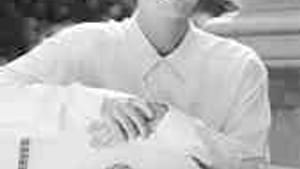Stay in the Loop
BSR publishes on a weekly schedule, with an email newsletter every Wednesday and Thursday morning. There’s no paywall, and subscribing is always free.
The glory that was Dresden, before the fire
Tempesta di Mare revisits Dresden

Tempesta di Mare's latest Baroque outing saluted the Dresden court orchestra, which flourished between 1694 and 1763, when Saxony's defeat in the Seven Years War ended Dresden's era of splendor. All the music on the program was composed for an orchestra renowned throughout Europe for the quality of its musicians as well as its in-house composers. Composers elsewhere in Europe happily contributed music that took advantage of Dresden's virtuoso performers and its large, varied forces.
Five of the program's six pieces exploited the contrasts between the strings and the six wind players lined up behind them. In the opening concerto by Johann Frederick Fasch, the winds entered the concert with a light, far off sound, like hunting music heard from a distant hill. Later in the movement, they massed forces and proved that Baroque instruments, played in unison, can produce big outbursts.
Two items on the menu stemmed from Fasch, the lost composer whose work Tempesta has gradually resurrected over the past few years with a computer-enhanced restoration of manuscripts that were water damaged during the bombing of Dresden in World War II.
The first Fasch concerto opened with a moderate allegro and continued with a solemn middle movement marked by stately, processional moments for two flutes. The opening allegro in the second concerto found Fasch in a sprightlier, more Vivaldian mood, with wind parts that blended and alternated with the strings. The middle andante included solos for flute, oboe, and bassoon, with the bassoon parts contributing some of the color that a horn normally adds to the instrumental mix.
Music suited to Molière
The rest of the program included an overture for Molière's play, The Hypochondriac, and a reprise of the Weiss lute concerto that Tempesta's co-director, Richard Stone, reconstructed in 2007.
Unlike many composers, Polish composer Jan Dismas Zelenka produced an overture that actually fit the subject of Molière's comedy. Musical effects, like groans from the winds and wails from the first violin, dot a gently mocking piece that's just as musical as less amusing contributions to the overture repertoire.
The Weiss lute concerto is actually a collaboration between Stone and an 18th- Century lute virtuoso, Silvius Leopold Weiss. Stone reconstructed the concerto from minimal remains: the lute part and a title page that describes Weiss' orchestration.
The lute is an exceptionally soft instrument, easily overwhelmed by an orchestra, but the concerto, as reconstructed, includes several passages in which the soloist plays alone, in between orchestral interludes. Stone once again demonstrated that the lute is the most refined and seductive of all the hand-held, hand-plucked instruments that humans have toyed with over the centuries.
Big Baroque sound
Vivaldi wrote several concertos for his friend Johann Pisendel, who led the Dresden orchestra during its peak years. His G Minor concerto, labeled "For the Dresden Orchestra," opened with a thundering allegro, proving that 22 musicians playing Baroque instruments can sound just as impressive as 60 musicians playing modern instruments.
In the final allegro, the big orchestra sound alternated with some stylish violin solos by Concertmaster Emlyn Ngai, and the afternoon ended with a thoroughly Vivaldian upbeat.
A proper review must include a mention of Tempesta's bassoon section. The deep-throated sound of the Baroque instruments played by Marilyn Boneau and Anna Marsh added major contributions to the color and mood of every piece that included wind music. Boneau, who served as the designated principal bassoon, contributed some notable individual moments, such as the long oboe and bassoon largo in the Vivaldi.♦
To read a reply, click here.
Five of the program's six pieces exploited the contrasts between the strings and the six wind players lined up behind them. In the opening concerto by Johann Frederick Fasch, the winds entered the concert with a light, far off sound, like hunting music heard from a distant hill. Later in the movement, they massed forces and proved that Baroque instruments, played in unison, can produce big outbursts.
Two items on the menu stemmed from Fasch, the lost composer whose work Tempesta has gradually resurrected over the past few years with a computer-enhanced restoration of manuscripts that were water damaged during the bombing of Dresden in World War II.
The first Fasch concerto opened with a moderate allegro and continued with a solemn middle movement marked by stately, processional moments for two flutes. The opening allegro in the second concerto found Fasch in a sprightlier, more Vivaldian mood, with wind parts that blended and alternated with the strings. The middle andante included solos for flute, oboe, and bassoon, with the bassoon parts contributing some of the color that a horn normally adds to the instrumental mix.
Music suited to Molière
The rest of the program included an overture for Molière's play, The Hypochondriac, and a reprise of the Weiss lute concerto that Tempesta's co-director, Richard Stone, reconstructed in 2007.
Unlike many composers, Polish composer Jan Dismas Zelenka produced an overture that actually fit the subject of Molière's comedy. Musical effects, like groans from the winds and wails from the first violin, dot a gently mocking piece that's just as musical as less amusing contributions to the overture repertoire.
The Weiss lute concerto is actually a collaboration between Stone and an 18th- Century lute virtuoso, Silvius Leopold Weiss. Stone reconstructed the concerto from minimal remains: the lute part and a title page that describes Weiss' orchestration.
The lute is an exceptionally soft instrument, easily overwhelmed by an orchestra, but the concerto, as reconstructed, includes several passages in which the soloist plays alone, in between orchestral interludes. Stone once again demonstrated that the lute is the most refined and seductive of all the hand-held, hand-plucked instruments that humans have toyed with over the centuries.
Big Baroque sound
Vivaldi wrote several concertos for his friend Johann Pisendel, who led the Dresden orchestra during its peak years. His G Minor concerto, labeled "For the Dresden Orchestra," opened with a thundering allegro, proving that 22 musicians playing Baroque instruments can sound just as impressive as 60 musicians playing modern instruments.
In the final allegro, the big orchestra sound alternated with some stylish violin solos by Concertmaster Emlyn Ngai, and the afternoon ended with a thoroughly Vivaldian upbeat.
A proper review must include a mention of Tempesta's bassoon section. The deep-throated sound of the Baroque instruments played by Marilyn Boneau and Anna Marsh added major contributions to the color and mood of every piece that included wind music. Boneau, who served as the designated principal bassoon, contributed some notable individual moments, such as the long oboe and bassoon largo in the Vivaldi.♦
To read a reply, click here.
What, When, Where
Tempesta di Mare: Fasch, Concerto in D; Hasse, Sinfonia to Lucia Papirio; Weiss, Concerto Ó cinque in C (Richard Stone, lute); Fasch, Concerto in D; Zelenka, Hypochondria; Vivaldi, Concerto in D Minor. Gwyn Roberts and Richard Stone, artistic directors; Emlyn Ngai, concertmaster. October 3, 2010 at Presbyterian Church of Chestnut Hill, 8855 Germantown Ave. (215) 755-8776 or www.tempestadimare.org.
Sign up for our newsletter
All of the week's new articles, all in one place. Sign up for the free weekly BSR newsletters, and don't miss a conversation.

 Tom Purdom
Tom Purdom